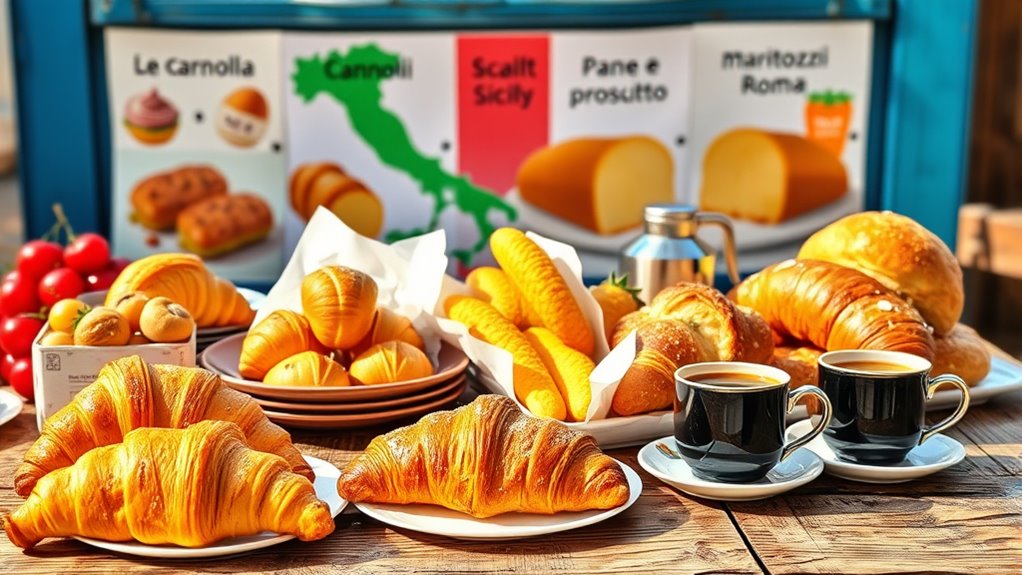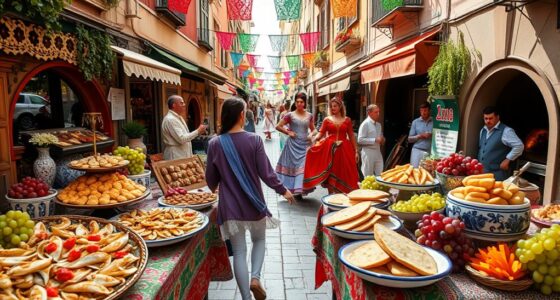Italian breakfast styles vary greatly across regions, shaped by history, culture, and local ingredients. In the North, you’ll find quick espresso and pastries, influenced by nearby European customs. The South prefers hearty bread with olive oil, ricotta, and preserves rooted in agricultural traditions. Central Italy offers simple cappuccino and cornetto, reflecting Renaissance cafe culture. Modern influences blend with these traditions, creating a diverse and evolving breakfast landscape worth exploring further.
Key Takeaways
- Regional differences shape breakfast habits, with Northern Italy favoring quick espresso and pastries, while Southern Italy emphasizes hearty, traditional options.
- Historical influences like Austro-Hungarian, Arab, and Norman exchanges contributed to regional ingredient diversity and breakfast customs.
- Urbanization and globalization introduce modern trends, blending traditional regional practices with international coffee culture.
- Rural areas tend to maintain traditional, homemade breakfast routines reflecting agricultural roots and local resources.
- The evolution of Italian breakfast showcases a balance between preserving regional identities and adapting to contemporary lifestyles.

Italian breakfast has evolved considerably over the centuries, blending traditional customs with modern influences. When you explore different regions, you’ll notice how regional variations shape the way Italians start their day. In the north, for example, breakfast often features a quick espresso paired with a pastry or a croissant, reflecting the influence of neighboring European cultures. These northern customs are influenced by historical trade routes and closer proximity to other countries, which introduced lighter, faster morning routines. Moving south, breakfast becomes more hearty and traditional. In places like Sicily and Calabria, you might find a focus on bread with olive oil, ricotta, or local preserves, showcasing a rich history rooted in agriculture and local ingredients. These regional differences come from centuries of historical influences, such as Arab, Norman, and Mediterranean exchanges, which left a lasting impact on local food practices.
You’ll also see that historical influences continue to shape breakfast habits today. For centuries, Italy’s diverse regions developed their own culinary identities, often tied to local resources and cultural exchanges. For example, the influence of the Austro-Hungarian Empire in northern Italy introduced richer, more substantial breakfast options, including meats and cheeses, which contrast against the lighter, bread-and-coffee routines favored elsewhere. In central Italy, especially around Rome, breakfast tends to be simple—think of a cappuccino and a cornetto, reflecting a history of urban sophistication and the influence of café culture that grew during the Renaissance. Meanwhile, in the rural south, traditional breakfast might still include homemade bread, seasonal fruit, and local cheeses, a *testament* to longstanding agricultural practices and regional customs. Additionally, the diversity of ingredients available across Italy continues to influence regional breakfast variations, reflecting Italy’s rich agricultural and cultural landscape.
As Italy modernizes, these regional distinctions persist but also blend with contemporary trends. Coffee chains and international influences have introduced new options, yet many Italians still hold onto their regional favorites. You might notice a morning routine that’s a quick espresso from a street kiosk in Milan or a leisurely, homemade breakfast in a small village in Tuscany. The evolution is ongoing, but the deep-rooted regional variations and historical influences continue to define how Italians welcome the day. This blend of tradition and change makes Italian breakfast a fascinating reflection of the country’s diverse cultural tapestry, allowing you to experience a unique culinary journey with every region you explore.
Frequently Asked Questions
How Do Breakfast Customs Vary Between Urban and Rural Italy?
You’ll notice breakfast customs differ between urban and rural Italy, reflecting local versus national traditions. In cities, people often grab a quick espresso and pastry, embracing modern routines. In rural areas, breakfast is influenced by rural agricultural traditions, featuring fresh, local produce like bread, cheese, and fruit. These rural customs emphasize wholesome, traditional flavors, while urban habits lean toward convenience and international influences.
What Are Traditional Beverages Accompanying Italian Breakfasts?
You’ll find that traditional Italian breakfasts often feature regional coffee culture, with espresso or cappuccino being popular choices. Alongside your beverage, regional pastry varieties like cornetto or bombolone add local flavor. These pairings reflect Italy’s diverse culinary traditions, blending rich coffee traditions with unique pastries from different regions. This combination creates a warm, authentic start to your day, showcasing Italy’s love for high-quality coffee and delicious, region-specific baked goods.
Are There Regional Differences in Breakfast Pastry Ingredients?
You might notice regional pastry variations across Italy, where local ingredient regionalism influences flavors and textures. For example, in Sicily, you’ll find pastries with citrus, while in Naples, they often feature ricotta. These differences aren’t just coincidence—they reflect local traditions and available ingredients. By exploring these regional pastry variations, you get a delicious glimpse into Italy’s diverse culinary heritage that makes each region’s breakfast unique and inviting.
How Have Modern Diets Influenced Italian Breakfast Choices?
You’ve probably noticed that modern diets influence Italian breakfast choices, as people seek healthier options. You might include global superfoods like chia seeds or acai, and cater to dietary restrictions such as gluten-free or vegan needs. This shift means traditional pastries are often replaced with nutritious alternatives, allowing you to enjoy familiar flavors while supporting your health goals. It’s a blending of tradition and modern wellness trends shaping your breakfast habits today.
Do Italian Children Have Different Breakfast Routines Than Adults?
Oh, the great breakfast showdown: children’s morning routines versus adult breakfast habits. You’ll notice kids often enjoy simple, sweet treats like biscuits or cereal, fueled by the energy they’ll need for play. Meanwhile, adults tend to stick to more traditional, savory options like espresso and bread. It’s amusing how these routines differ—kids’ breakfasts are quick and fun, adults’ are a ritual of sophistication, yet both fuel their day.
Conclusion
As you’ve seen, Italian breakfast traditions have woven together history and regional flavors like a colorful tapestry. Imagine savoring a croissant in Milan or a cannolo in Sicily—each morning, you’re tasting centuries of culture. Just like a morning sunrise gradually paints the sky, Italy’s breakfast evolution reflects its rich diversity. So next time you enjoy a simple espresso or pastry, remember you’re part of a flavorful journey that keeps evolving, yet stays beautifully rooted in tradition.









